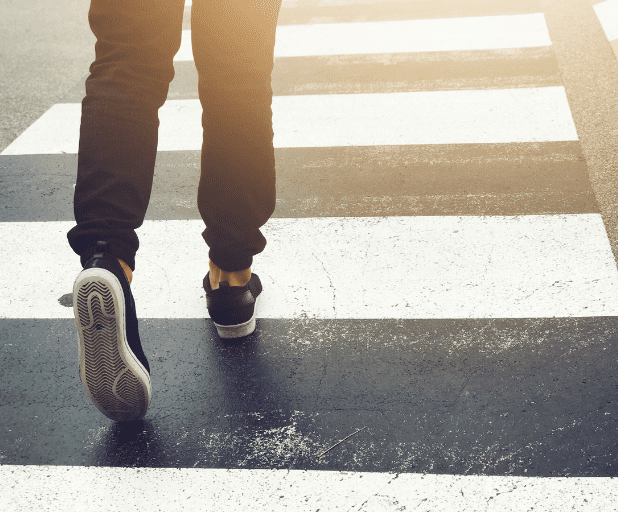In 2021, an average of eight pedestrians died and 115 were seriously injured (adjusted) per week in reported road collisions. Statistics also show that “the most common contributory factor allocated to pedestrians in fatal or serious collisions with another vehicle was ‘Pedestrian failed to look properly.’ The most common factor allocated to the vehicles involved was ‘Driver or rider failed to look properly’”.
Pedestrian accidents can cause severe physical and emotional trauma, impacting a person’s life in several ways. Seeking compensation not only provides the victim with a sense of justice, but it can also be essential for obtaining the funds required to access quick, effective rehabilitation.
What are the common injuries associated with pedestrian accidents?
Pedestrian accidents can result in various injuries, ranging from minor to severe. Examples include:
- Soft Tissue Injuries – these include bruises, sprains, strains, and contusions. Soft tissue injuries are common in pedestrian accidents due to the impact of the collision, which can cause damage to muscles, tendons, and ligaments.
- Fractures – pedestrians can suffer bone fractures, such as broken arms, legs, wrists, hips, or ribs, when they are struck by a vehicle. Fractures can vary in severity, from hairline fractures to compound fractures that break through the skin.
- Head Injuries – head injuries are common in pedestrian accidents. These injuries can range from concussions and contusions to more severe traumatic brain injuries (TBI). Head injuries can have long-term effects on cognitive function and overall well-being.
- Back and Spinal Cord Injuries – when a pedestrian is hit by a vehicle, the impact can lead to back injuries, such as herniated discs, spinal fractures, or damage to the spinal cord. Spinal cord injuries can result in partial or complete paralysis, depending on the location and severity of the injury.
- Internal Organ Damage –the force of impact can cause internal injuries, such as damage to the liver, kidneys, spleen, or lungs. These injuries may require immediate medical attention and can be life-threatening if not promptly treated.
- Cuts, Lacerations, and Abrasions – pedestrians may suffer from cuts, lacerations, and abrasions due to contact with the vehicle or the road surface. These injuries can range from minor cuts requiring stitches to more severe lacerations that may damage nerves, blood vessels, and tissue.
- Psychological Trauma -being involved in a pedestrian accident can also result in psychological trauma, such as post-traumatic stress disorder (PTSD), anxiety, or depression.
It is important to note that the severity of injuries can vary greatly depending on factors like the speed of the vehicle, the point of impact, and the overall health of the pedestrian. Older people and children may suffer greater damage than a fit, strong adult.
How much time do I have to bring a personal injury claim for a pedestrian accident?
In most cases, you must bring a claim for personal injury within three years of the accident. If you try and bring a claim after three years, time limit, have passed, the defendant will apply to the Court to have your claim struck out. The Court does have the discretion to waive the limitation period and allow the claim; however, this is extremely rare, and you will need to provide solid evidence that there is good reason for the Court to use its discretion.
There are exceptions to the limitation rule including:
- Children – if the accident occurred when the victim was a child, the three-year limit begins to run after they turn 18 years old.
- Date of knowledge – in some cases it can be difficult to establish when the negligence took place. Therefore, the limitation period begins to run from the date the victim became aware of the injury which resulted from the negligence (referred to as the ‘date of knowledge’). This is rare in pedestrian accident claims.
- Lack of capacity – if the victim suffers an injury which results in them losing capacity to bring a claim, the limitation period begins to run from the date they regained capacity. If they never regain capacity, a claim can be brought at any time by a Litigation Friend.
- Death – if the victim dies from their fatal injuries their estate can bring a claim within three years of the date of the victim’s death.
Even if you suspect the limitation limit has passed it is still crucial to talk to a Personal Injury Solicitor who can advise you of your options and claim process.
How do I prove negligence in a pedestrian accident case?
To succeed in a personal injury claim, you need to prove, on the balance of probabilities that:
- The Defendant owed you a duty of care,
- They breached that duty, and
- This resulted in you suffering damage.
There are various things you can do to support your claim, including:
- Keeping all hospital and medical records.
- Collecting the names and contact details of any witnesses to the accident.
- If possible, take photographs of the accident scene.
- Ensure the police are called and take a copy of the police report.
Pedestrian accidents can have life-altering consequences, leaving victims physically, emotionally, and financially devastated. Making a personal injury claim is a vital step towards rebuilding your life. By instructing an experienced Personal Injury Lawyer, you will give yourself the best chance of being awarded compensation. This will allow you to focus on your recovery and move forward to a positive future.
Our team has decades of combined experience in successfully advising and representing clients in personal injury cases resulting from pedestrian accidents. We are sympathetic and understanding and are here to help you every step of the way.
Call us on 01 625 667166 or email us today to discuss your claim.
